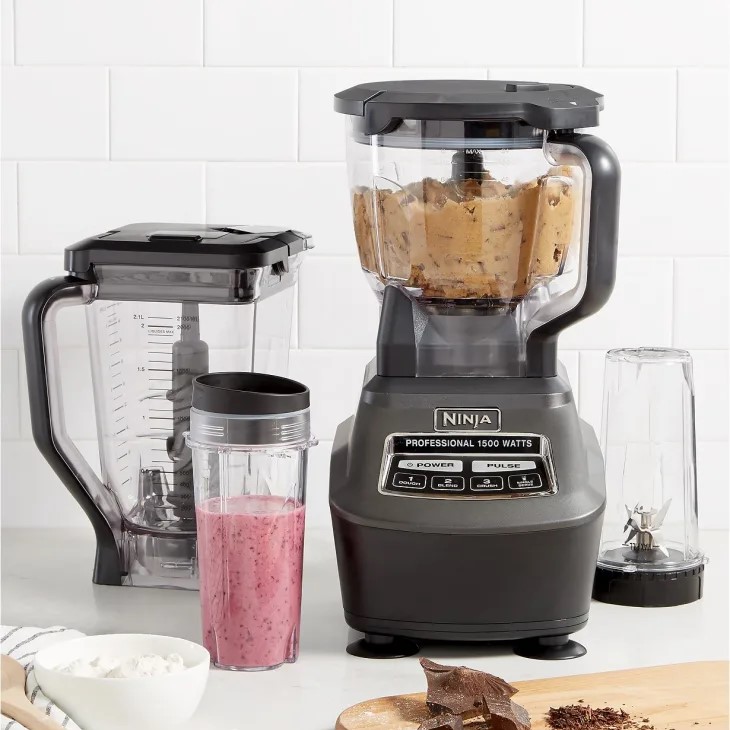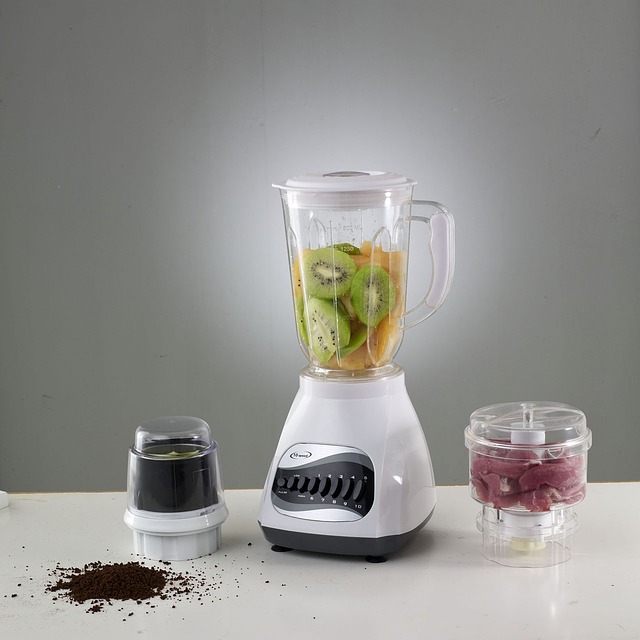
Blender and Food Processor: An Overview
When it comes to kitchen gadgets, blenders and food processors top the list. Each serves unique purposes, mastering specific tasks to make cooking a breeze. It’s time to dive into their capabilities, attachments, and when to use which. Let’s start this culinary journey.

Introduction to Kitchen Appliances
Kitchen appliances transform the way we cook, adding speed and precision. Blenders and food processors do just that but in different ways. Know the right appliance to pick for your recipe can make all the difference.
Key Features of Blenders
Blenders shine when it comes to liquids. They possess strong blades ideal for smoothies, soups, and sauces. Their design creates a vortex that pulls ingredients towards the blades, ensuring a fine blend.
Key Features of Food Processors
Food processors boast multipurpose use. They master tasks like slicing, dicing, and dough-making. With various attachments, they handle solid foods with ease – something blenders can’t always do.
Comparing Performance & Uses
Blending Capabilities of a Blender
Blenders excel with liquids. They are perfect for creamy soups, smoothies, and sauces. High-speed blades and a vortex-effect efficiently blend ingredients for smooth textures.
Versatility of a Food Processor
Food processors handle multiple tasks. They chop, slice, and knead with ease. With different attachments, they manage solid foods better than blenders. They are ideal for making dough, chopping veggies, and more.
Both blenders and food processors can purée and mix. They are useful for making dips like hummus and sauces. However, their effectiveness varies with the consistency of the mixture.
Attachments and Accessories
Understanding the variety of attachments and accessories will enhance your cooking experience with both blenders and food processors.
Blades and Discs for Food Processors
Food processors come with a range of attachments. They include:
- S-shaped blades: Best for chopping and pureeing.
- Slicing discs: Provide uniform cuts of veggies and fruits.
- Shredding discs: Ideal for cheese and vegetables.
- Dough blades: Mimic kneading action for perfect dough.
These attachments allow food processors to tackle a range of tasks, from grinding meat to kneading dough. They save you time and effort in the kitchen.
Jug and Blade Types for Blenders
Blenders typically have less variety in attachments but include:
- Fixed blades: Designed for blending and pureeing.
- Tall, slim jugs: Create a strong vortex for smooth blends.
Some blenders come with a tamper to push down ingredients. This is helpful for thicker blends. High-powered blenders might also feature variable speed controls for different textures.
Blenders work best with liquids. They make sure your smoothies and soups turn out silky smooth. On the other hand, food processors offer more versatility with their range of attachments. They are the go-to for more solid food prep tasks. This includes slicing veggies or making doughs. Each appliance has its strengths. Choose based on what you cook most often.
 Practical Recipes for Each Appliance
Practical Recipes for Each Appliance
Gearing up to use your kitchen appliances? Let’s explore some ideal recipes for both food processors and blenders. You’ll find they can be your best friends in the kitchen.
Ideal Food Processor Recipes
Food processors shine with their versatility. Here are some recipes that highlight their prowess:
- Homemade Pesto: Fresh basil, pine nuts, and parmesan get quickly chopped and blended into a classic spread.
- Salsa: Dice tomatoes, onions, and cilantro for a zesty, fresh dip ready in minutes.
- Shredded Carrot Salad: Shred carrots fast and mix with dressing for a crunchy side dish.
- Chickpea Falafel: Mix chickpeas, herbs, and spices, then shape into patties for frying or baking.
- Pie Crusts: Combine flour, butter, and water to form a perfect dough without the hassle.
These tasks showcase the food processor’s ability to chop, blend, knead, and shred, making cooking easier and faster.
Must-Try Blender Recipes
Blenders are perfect for smooth textures and liquid recipes. Here’s what you can whip up:
- Green Smoothies: Blend leafy greens with fruits for a healthy, on-the-go snack.
- Pina Colada: Crush ice with pineapple and coconut milk for a tropical treat.
- Tomato Soup: Puree cooked tomatoes and herbs for a warming meal.
- Pancake Batter: Mix ingredients for a smooth batter ready to hit the skillet.
- Mango Sorbet: Combine frozen mango and a dash of juice for a quick dessert.
These blender recipes are great for when you need something whipped up that’s smooth and sippable or pourable. Try them out, and you’ll see how a blender can transform the way you prepare drinks and desserts.
Making the Right Choice for Your Kitchen
Choosing between a food processor and a blender is like picking the right tool for a job. It depends on your cooking style and what you make often.
Understanding Your Cooking Needs
Think about the dishes you love to cook. Do you lean towards smoothies and soups? A blender is your friend. If you chop lots or make dough, a food processor is better. Ask yourself, ‘What will I use more often?’ This will guide your choice.
Each appliance shines in different scenarios. A blender works well for drinks and soft purees. A food processor excels in solid food prep, like slicing and mixing. Matching the appliance to your cooking tasks is key.
Evaluating Appliance Versatility
Food processors come with many attachments. They chop, dice, slice, and even knead. Blenders usually have a single blade. They blend and puree mostly liquids.
For kitchens with limited space, choosing one that can do many tasks is smart. But if you often do both liquid and solid preps, consider having both appliances. With both, you tackle a wide range of recipes.
Choosing between these kitchen helpers depends on your cooking needs. Consider the variety of tasks you do. Then, select the appliance that will save you time and effort in the long run.
While both blenders and food processors can do similar tasks, knowing when to use each can simplify your kitchen routines. Their purposes can overlap, but they’re tailored to suit different types of ingredients and textures. Here’s a guide to understanding which appliance to use for achieving your culinary goals.
When to Use a Blender
Grab your blender when you’re aiming for smooth, liquid-based creations. Blenders excel at:
- Making Smoothies: Combine fruits, greens, and liquids for a quick healthy treat.
- Pureeing Soups: Blend cooked veggies and broth until silky smooth.
- Whipping up Sauces: Create salad dressings and marinades with a liquid base.
- Mixing Drinks: Craft milkshakes or blend ice into cocktails with ease.
Blenders are less effective with dry or chunky textures. If your recipe involves liquid and requires a smoothly blended result, a blender is the go-to appliance.
When to Use a Food Processor
Turn to a food processor for tasks that need more than just pureeing. Food processors are great for:
- Chopping Vegetables: Get uniform pieces quickly for salads or cooking.
- Making Dough: Combine and knead ingredients for breads and pastries with ease.
- Grating Cheese: Shred blocks of cheese for recipes or toppings without strain.
- Preparing Dips: Create thicker, chunky dips like salsa where you control the chunk size.
Food processors tackle solid, bulky foods with precision. They’re the champions of texture and versatility in solid food prep.
 FAQs on Choosing Between a Blender and Food Processor
FAQs on Choosing Between a Blender and Food Processor
Common Questions and Answers
Choosing between a blender and a food processor can be puzzling. Here, we answer common questions to help you decide.
- What’s better, a blender or a food processor?
This depends on your needs. Use a blender for smooth mixtures like smoothies and soups. A food processor is better for solid food tasks like chopping and kneading.
- Can I use my blender as a food processor?
Sometimes, but not always. Blenders handle liquids well but struggle with solid, dry mixtures.
- What can a food processor do that a blender cannot?
A food processor can chop, slice, grate, and knead. It handles solid, bulky foods with ease, unlike blenders.
This section aims to clear your confusion, making your kitchen appliance choice easier.





